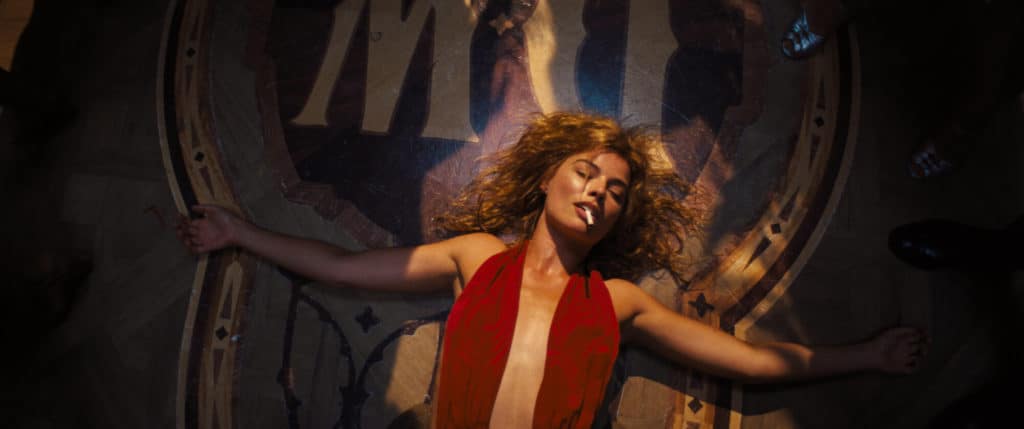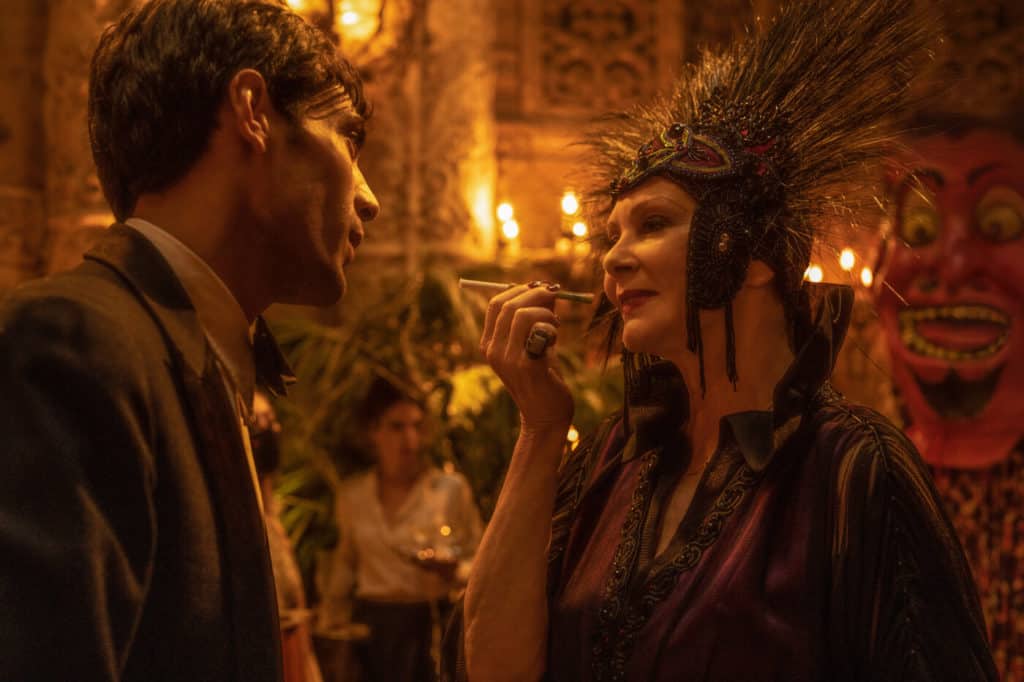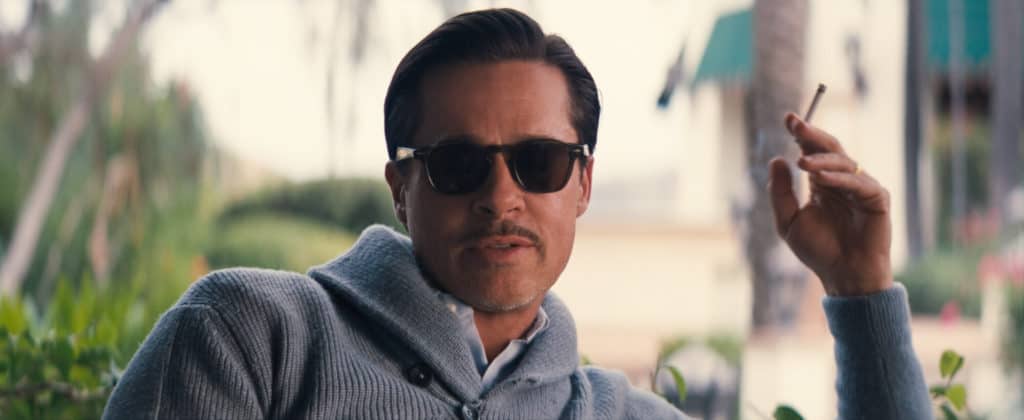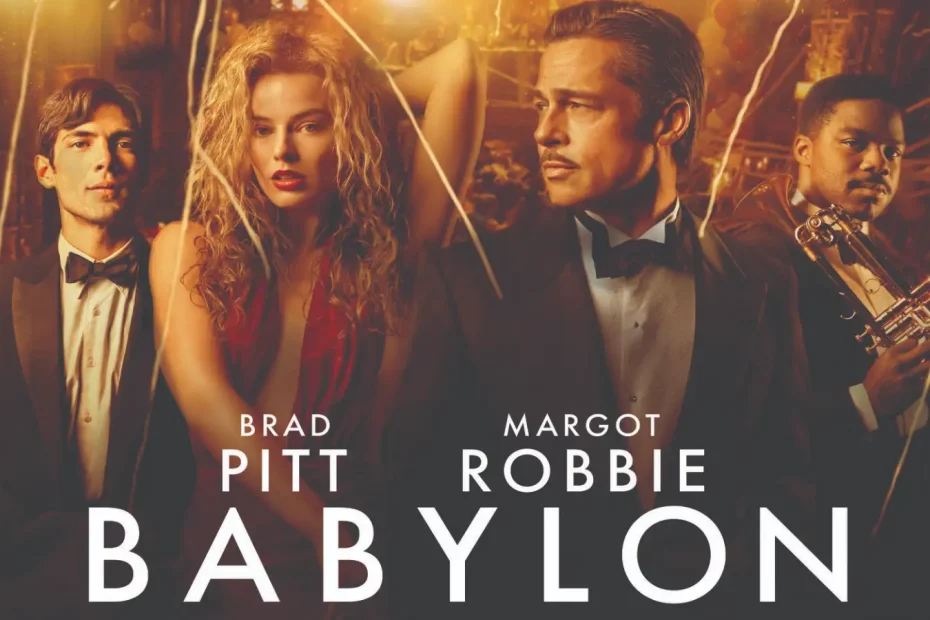78 Million dollars says my pocket calculator
Babylon is the fifth film by Damien Chazelle. Apart from the debut feature, all his previous films have been successful, from Whiplash, followed by La la Land (2016), which almost won an Oscar for best film and First Man (2018). Babylon is his most expensive film so far, with a reported budget of 78 million USD. On the surface, the film is set in the 1920s and describes the era of silent films and when it suddenly transforms into talkies. Basically, we will follow three characters. Manny Torres (Diego Calva) makes a career behind the camera while witnessing what Hollywood is really like. Jack Conrad (Brad Pitt) is a silent movie star struggling with the transition to talking pictures.
Most notably, we meet Nellie LaRoy (Margot Robbie), who seems to slip into the business on a banana peel. She will become a striking, if not compelling, character throughout the film. Probably everyone knows how the film begins. Manny is trying to bring an elephant to a lavish party over a hill. It doesn’t end well, with the elephant defecating all over a man and into the camera. How to interpret this scene? Chazelle might see it differently than the spectator. Apparently, he thinks that it signals a work where anything outrageous might occur. For a discerning viewer, it might actually be an involuntary disclosure of what the film consists of and that it will be all downhill from here.

I’m the operator of my oversaturator
The film unfolds in a succession of set pieces. The first one depicts the aforementioned party, which begins with a girl urinating on an obese man before we enter the festivity area with loads of nude people dancing, gyrating, and presumably having a great time. It’s all captured by Linus Sandgren’s camera swooping around. Here he begins a pattern that will become repetitive throughout the film when he closes in on the trumpet player. It’s not the sole element that will feel repetitive during the 189-minute runtime. The striking thing with these oversaturated scenes, which ostensibly are filled with action, is how lifeless they seem. The Kraftwerk seems to have run out of power, regardless of the movements involved.
Already at this early stage, what we experience is nothing new, but feels like it’s culled from other, better films. The girl who was urinating and later having sex with the obese man will collapse and need medical assistance while the drug-fueled party goes on next door. Whether that brings to mind Eyes Wide Shut (1999) or any other film with plenty of debauchery makes little difference. From the very start, a film that is supposed to be flying freely instead clumsily staggers around with no aim in sight. When the location later switches to film sets, that does little to improve things. A female director (Olivia Hamilton) struggles to direct Nellie in a scene that feels weirdly modern.

Babylon of the Vanities
Among the many films that Babylon pays homage to or merely takes things from, the most prominent is Singin’ in the Rain (1952). It shows a certain confidence on Chazelle’s part to reference such a famous film, especially since the variation of those scenes in his own film play like pale copies. The main difference is that even if Singin’ in the Rain illustrates the difficulties of the transition to talkies, it’s a love letter to cinema and also a film with a masterly rhythm whether the protagonists dance or not. This film is more akin to Brian De Palma’s Bonfire of the Vanities (1990). A film whose production was so disastrous that it spawned a book about the process.
The book in question is The Devil’s Candy by Julie Salamon. One of the stories recounted by the author is when Melanie Griffith comes back to the set after a hiatus with enhanced breasts, causing problems with the continuity. Nellie LaRoy does the exact same thing in Babylon. Yet another piece of the film that seemingly takes it out of the era when it’s purportedly taking place. Are we dealing with anachronisms here? If the female director feels modern, one could still argue the fact that they were more common in the silent days than during the sound era. The character seems to be inspired by Dorothy Arzner. This doesn’t change the fact that it still rings suspiciously modern.

Many great and complex films are derived from disparate components that fit into a meticulous design. However, that requires a well-conceived structure, which is glaringly missing in Babylon. Chazelle chose, once again, to write the script on his own. Once again, I wonder what happened to script doctors. The film plays like a rough cut in dire need of severe pruning. What is supposed to be chaotic and overwhelming rather comes off as loud and monotonous. It’s an exhausting experience. The weirdest thing is that with all the sex and violence on display, the film feels almost prudish in its outlook. It’s as ill-disciplined as a Fellini film, but even he understood the value of rhythm.
Another director who comes to mind is Blake Edwards. Not only for his tumultuous and improvised The Party (1968), complete with an elephant in the room, but also for his attempt at a Hollywood satire S.O.B (1981). Just like Babylon, it was a box-office flop, and as a film, it was all over the place. The acronym not only stands for the obvious son of a bitch, but also for Standard Operational Bullshit. That would be an apt description of Chazelle’s work, as well. To quote another famous film of 2022, he could loudly exclaim, “I sell shit”. It turned out there were not that many buyers around this time.
Ending Explained?
Spoilers of the ending will follow
The actors are basically abandoned. Jeff Garlin seems to have fun as a Harvey Weinsteinish character. Jean Smart is a standout as a reporter who knows the truth but understands the facts of life, as well. Towards the end, Tobey McGuire enters the picture, and now I was eagerly waiting for the supposedly most terrifying part of the film. It turned out to be another disappointment with a lame reenacting of the geek in Nightmare Alley. The remake of that film shares many faults with Babylon, even though it’s easier on the eyes and the mind, as well. After a final attempt to create a tragic moment for characters we never cared for, it’s time for the not-so-grand finale.
Manny enters a cinema that is screening Singin’ in the Rain. A film that has already been referenced ad nauseam. One could ask how wise it is to remind the spectator of a far superior film, but Chazelle will take the meta-level one step deeper, and with that, I mean spiralling downwards. After a “best of” collection of the film we just endured follows a rapid montage of scenes going through cinematic history. From The Horse in Motion, going chronologically to our days, including the fin du cinéma quote from Weekend up to Avatar, followed by Persona. After some Stargateish colour explosions, we see Manny in tears. What does all of this mean?
One thing for sure: much less than Chazelle thinks. More interestingly, I think it shows that the aim of the film is not to portray a past era but attempt to reflect on what’s happening with cinema. The director is a confirmed celluloid nostalgic, and in many ways, the film feels like a comment on the industry today which is as ruthless as it was then, albeit in other ways. Babylon is a kind of hate letter from a director who is not happy with the current state of cinema. I share those sentiments, but the main problem with Babylon is that it’s rather an example of everything wrong with cinema today than a depiction of it.



